Chinese laser engraving machines have come a long way over the years, proving invaluable in a variety of industries. Their capacity to cut and engrave a wide variety of materials is perfect for trophies, signage, crafts, and even personal novelties. Compared to many other industries, laser engraving has a low entry level requirement, yet a generous skill ceiling. The ability to use a laser engraver can spark the beginning of a home business on its own, and this has led to an inevitable conundrum for consumers – What machine should they buy? How much does one need to spend? What are the hidden pitfalls that brochures neglect to mention?
Search engines like Google, and websites like eBay, will lead potential customers to vastly different laser engraver options. On one hand, we have expensive American-made machines like Trotec and Epilog, and on the other hand, much cheaper Chinese alternatives. While it cannot be refuted that the American machines have superior lasers, build quality, software, and service, are the Chinese machines close enough in comparison to warrant saving thousands of dollars? The short answer is… yes.
Introducing my machine; the Jinan Derek 9060 CO2 Laser Engraver.
By the time you read this, this particular machine will be replaced by a newer model. Chinese laser engraving machines tend to evolve quickly, which is testament to how much momentum these things are gaining. This, of course, is a good thing for the future of Chinese laser engravers.
The machine featured in this article is the Jinan Derek 9060 CO2 Laser Engraving Machine. Jinan Derek is the manufacturer of this machine, and consumers will encounter many rebranded and recoloured variants all over the internet from resellers. Most rebranded machines are essentially the same as their source design, save for a few minor attachment inclusions or exclusions. For anyone already decided about purchasing a Chinese laser engraver, I would recommend ordering a machine direct from the maker. This will ensure that customer service has English speaking reps, and if replacement components are needed, they will be more easily acquired. The warranty, likewise, may also be more trustworthy if direct from a manufacturer.
The specs for this machine were comparable to other brands of Chinese laser engraver, with notable exception to a few components that were listed as a superior grade to what is normally in these machines. So the specs are as follows:
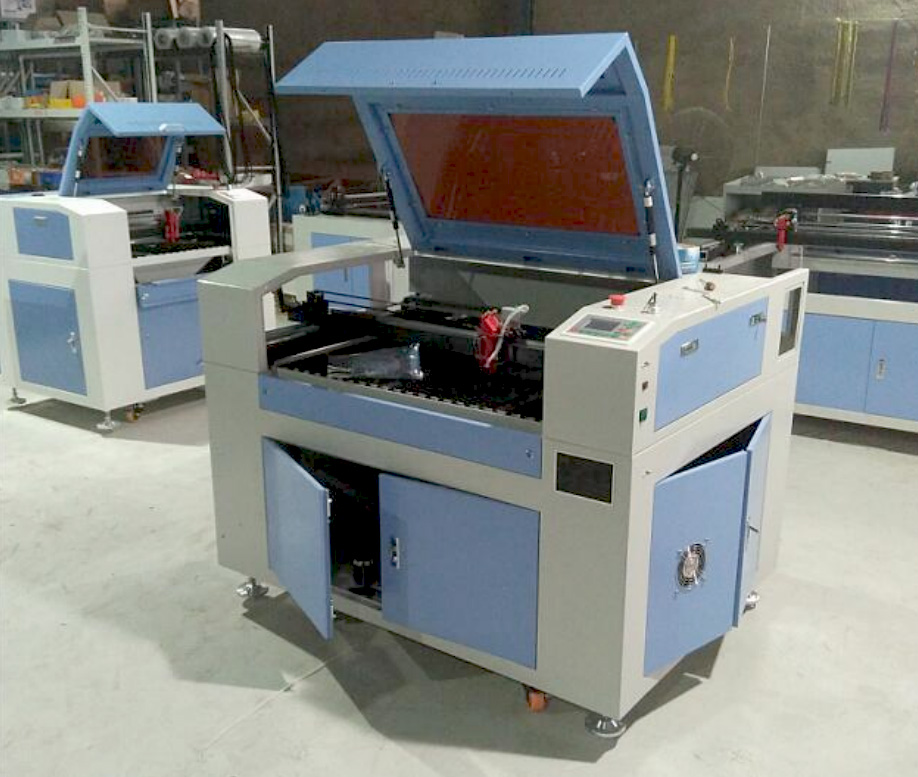
Working Area: 900mm x 600mm
Prior to purchasing this machine, I was seeking a slightly smaller bed size (700mm x 500mm). There were some out there in the market, mind you, though the difference in price was so marginal compared to this larger more powerful machine that it was a no-brainer.
The working area of 900mm by 600mm is made up of removable vertical slats, as well as a honeycomb bed that can be placed on top (better for smaller material). There’s an issue with aligning material atop the honeycomb bed, however, as there is no right angle reference point other than the corners, which are not accurately straight. Even if they were, the honeycomb bed sits loosely on the slats, and is not a reliable gauge of anything.
80 Watt CO2 tube (RECI)
Chinese RECI tubes are touted as having longer life spans than the marginally cheaper generic tubes. Whilst older style Chinese tubes are feared to fail prematurely or suffer problems out of the box, the newer RECI tubes are steadily gaining a reputation of reliability and longevity. It is the general rule of thumb that if a tube has no problems within the first few months, chances are it will continue going for a reasonable duration of its lifespan. Mileage varies for everyone, of course, though it can help to not run the tube at maximum power outputs, at least not often.
As far as the RECI tube I have in my machine, it has performed very well. There have been no issues whatsoever, and the power output seems consistent. If it lasts a reasonable portion of its 10,000 hour quoted lifespan, it will more than pay for itself many times over. It’s worth to note that Chinese lasers are significantly cheaper than American lasers. The only caveat to Chinese lasers is that they require water chillers to keep them cool, and that their quoted lifespan is less than American lasers. But the price/lifespan comparison between American lasers and Chinese lasers puts the latter far ahead, in my opinion.
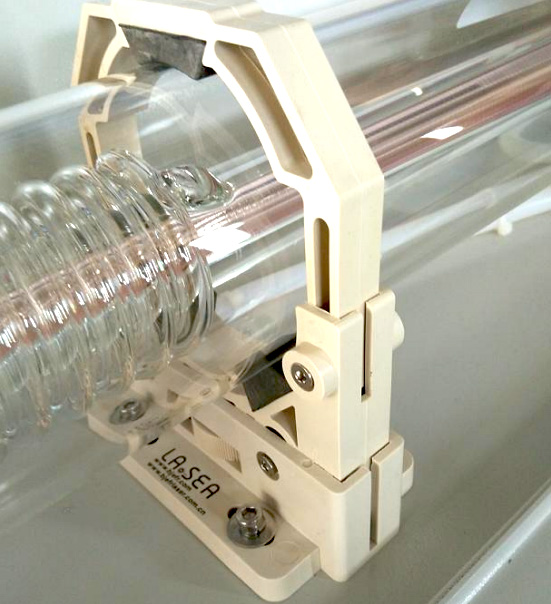
CW3000 Water Chiller
CO2 laser tubes from China need to be cooled by water when in operation. In the absence of a water chiller, a laser tube will overheat, and could potentially damage the tube. I have even heard reports of fires being started when chillers have failed and machines were left unattended.
The CW3000 water chiller is common among Chinese laser engraver packages, and it performs adequately enough to pump water into the laser tube, and then out again in a flowing cycle. The common misconception with water chillers is that they do not lower the temperature of the water to a predefined level, but instead maintain the temperature to match ambient room levels.
Things to note about the CW3000 water chiller: Use pure water or distilled water, and replace accordingly when needed. A user also needs to make sure that the laser tube is free of bubbles when first turning on the machine, which can take a minute for the water to filter through properly. If bubbles don’t filter out, the tube may need to be turned slightly in its bracket so that the bubbles can escape. This can also, unfortunately, upset the alignment of the laser and the mirrors, so be warned.

Air Pump and Exhaust Fan
The air pump and exhaust fan are both necessary components to any laser engraving machine. The air pump keeps the engraving focal point free of grit and fumes by blowing air downwards, and also helps to prevent smoke from entering the head and staining the lens (which needs to be kept clean, along with the mirrors). Without the air assist pump, fumes can ignite from materials like plastic when cutting.
The exhaust fan is purely for fumes, which basically means everything that is cut or engraved inside the machine, to varying degrees. The exhaust fan has limits, and does not protect against certain harmful plastics that, when burned, produce toxic fumes. So do your research and know what can and can’t be cut in a laser engraver safely without breath masks.
Both the Air Pump and Exhaust Fan work adequately enough for their intended purpose, though the ventilation tubing I received for my machine could have been longer. Luckily, tubing such as this is widely available and cheap to procure.
Speed: 6000mm/sec
It needs to be said that the speed of Chinese laser engraving machines is inferior to American laser engravers. This is due to the Stepper Motors of Chinese laser engravers compared to Servo Motors of American machines. Some Chinese machines can be purchased with Servo Motors included, though this brings the cost up considerably.
In any given circumstances, the speed of a job on a Chinese laser engraver should not exceed 500. Going beyond this parameter can cause overshooting when cutting, and a loss of fidelity when engraving. Depending on what industry the laser engraver is needed for, the slower speeds may be a concern. This can be remedied by purchasing a second Chinese laser engraver, which still works out cheaper than a single faster American machine.
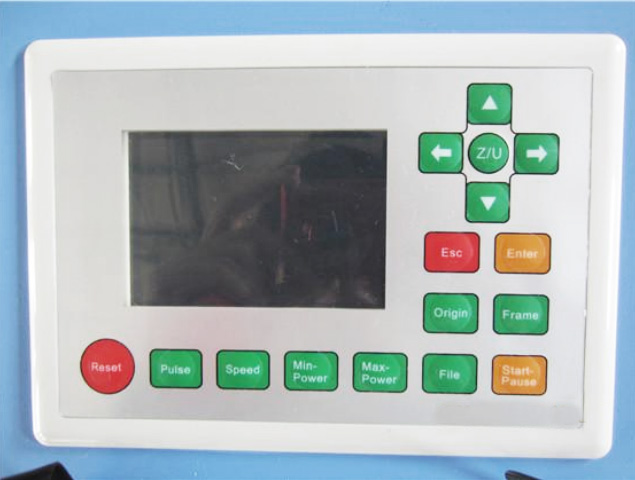
Software: RDworks
This is where things get interesting. RDworks is a common program shipped with Chinese laser engraving machines. The user interface is intuitive enough, and it has everything most users need to set the parameters of their jobs, minus a few critical omissions that many would argue are needed. Two of the biggest missing features I’ve found when using RDworks, is that text cannot be centrally aligned in a paragraph. The second is that multiple passes cannot be set for engraving and cutting.
RDworks comes with a lot of configurable settings under the hood, and very little to explain what each setting does. The PDF manual supplied with the software is poorly translated from Chinese, and the information is frustratingly threadbare. Much of the manual explains what the name of a function is, but doesn’t go into specifics about what it does. Hence, there is a definite learning curve with this program, even for experienced laser engraver operators. You will thank the gods for the existence of YouTube and Google.
When it comes to actually creating a job from scratch, most users will find RDworks too lacking or cumbersome, and instead opt for external software better suited for the task. RDworks supports many file types, though there are often numerous problems when importing an external file into RDworks. These problems can often be resolved through trial and error or using different file types, but nonetheless, RDworks is rage-inducing and long overdue for a QoL pass.
It is important to note that RDworks is essential to the operation of most Chinese laser engravers (not including buggerizing around with USB sticks). Unlike other machines, the software driver does not pose as a printer driver, so simply launching a job from your favourite CAM or CAD software will not work. And having to double the workload by sending a job to another program can be tiring, particularly if there are issues that always need to be addressed between the file translation.
Overall, RDworks is functional, and probably better than it has any right to be considering that it is a free program from a country notorious for cutting corners. But the software has a long way to mature, and is undoubtedly the single greatest sore point of purchasing a Chinese laser engraver.

Performance
The performance of this machine has only one demerit, and that is with its speed. As for cutting power and engraving resolution, there is little difference between this and much more expensive American machines I have used. Keeping in mind that Chinese laser tubes typically have a minimum output percentage before they fire, so getting a machine way too overpowered for the intended work may not be a good idea. A safe bet is somewhere between 50 – 80 watts. If you plan on exclusively cutting thick material like 10mm acrylic, however, then a higher wattage machine will be to your advantage. Just don’t buy a 300 watt tube if you plan to cut paper stencils.
Rotary Attachment
The rotary attachment for my Chinese laser engraver was surprisingly easier to use than a comparative one from Trotec. RDworks will be your only hurdle, as you need to ‘enable’ rotary engraving in the settings, and likewise, perform your own math when calculating circumference. Otherwise, setting up the job file was more intuitive on RDworks, and I had the luxury of commencing my job anywhere on the Y axis (rotation).
As for hardware, connecting the rotary involves swapping connections on the circuit board that may confuse newcomers. The Chinese Rotary attachment works by placing the glass over the aperture and expanding the aperture outwards until it clamps the inside of the glass. That clamp can also be used to grip thinner cylindrical objects. The point on the end is there simply to hold the engraving object in place.

Machine Setup
Chinese laser engravers come shipped in a sturdy wooden box, with many of its essential attachments are packaged inside the machine body. Setting up the laser engraver involves extracting all the attachments, which include the water chiller, air blower, and air extractor. The laser tube also comes separately inside a box, which needs to be installed by hand.
There is a learning curve involved in all this, though the manuals are helpful and adequate to guide new machine owners. The software needs to be installed on a computer as well, and that process is pleasantly straightforward. But make no mistake, the installation, setup, and learning to use the machine, is purely in the ballpark of the user. The more expensive American-made machines are more entry-level friendly, and often have home delivery / installation support.
Mirror Alignment
Chinese laser engravers will not have their mirrors aligned straight out of the factory. This is because of the self-installation requirement of the laser. Put simply, mounting the laser to the brackets, or shifting its position, will throw out the alignment.
The time it takes to align the mirrors depends on luck, intuition, and experience. Aligning mirrors inside a laser engraver could take hours, or at worst, days. There are many guides on the internet that explain this process, but the general rule of thumb is to start with the closest mirror to the laser and work your way around, leaving the laser engraver head mirror for last. Without making this a ‘how-to’ guide, the basic idea is to get the laser firing at the same spot on each mirror at both ends of the rails. Do this for the first and second mirror, and you’ll be able to succeed in aligning it with the third.
The negatives
If I was to nitpick about my Chinese laser engraver, these would be my main gripes.
RDworks.
This software should only be used as a platform in which to launch imported jobs. Granted, there is significant ease when setting Power, Speed, DPI, etc. But there are a thousand other settings in this software that have no explanation, and their name labels are open to interpretation. Not only this, but importing jobs from ‘better’ software is never a clean process.
Auto Focus
The auto focus attachment is a fixed pen-like protrusion that runs vertically beside the laser lens head. It is designed to focus the laser distance between the material to be engraved. Sounds handy, right? Well… sort of. The auto focus pen is fixed in place, and since it cannot be retracted, it is prone to hitting material that is not perfectly flat. This leads to ruined jobs and wasted material. Personally, it is safer simply to use a 10mm spacer to measure the distance and leave the auto focus pen out of the equation.
Honeycomb bed
The Honeycomb Bed is a double-edged sword. On one hand, it allows air flow, and it is not something that needs to be cleaned regularly like solid beds. But on the other hand, the corners are not straight, which amounts to extra time needed when setting up material.
Lens Head
This is largely about cleaning the lens. Both the mirror inside the head and the lens are difficult to get to, and require disassembling the head to get to them. This is not a fun task on a weekly basis, and more expensive machines have proven to be easier in comparison.
Cheap versus expensive – My final thoughts
To preface my thoughts about this, I have used machines that were expensive, as well as machines that were cheap, and I have even operated much larger engraving lasers for industrial applications. The debate about cheap vs expensive laser engravers can sometimes be decided purely on personal budget. The only negative to getting an American-made laser engraver is the cost of the machine, the repairs, and the replacement components. Otherwise, the American machine wins in every aspect, as it rightly should for the considerable difference in price.
Expensive machines, like the Trotec line, are easier to use and maintain, and are less likely to break down due to better build quality and components. But Chinese machines are very cheap to fix. Would you be happy with a $60,000 machine with lasers that cost $20,000 to replace? Or would you prefer a $3,000 machine with lasers that cost $700 to replace, except that it runs slower and has a higher learning difficulty level? This is perhaps oversimplifying the comparison between American and Chinese laser engravers, but the point still stands.
Of course, not all China-made laser engravers are the same, and there are a lot of them out there in the wild. However, I think we are past the point of fearing what turns up on our doorstep from China. These machines are decently built, and the components are getting better with each iteration. Most people I have spoken to say that their Chinese machine only had minor niggles when it arrived, things that were easily fixed or overcome. And more noteworthy was that the laser tubes in these machines were lasting their documented lifespan, with some exceeding it. This is no guarantee of anything, but it is certainly comfort for thought, more than we ever had before.
So would I buy another Chinese laser engraver? Absolutely.
TLDR: Chinese laser engravers can perform the same job as more expensive options, bearing in mind lesser speeds, usability obstacles, and a much steeper learning curve. Recent user experience has proven that Chinese laser engravers are capable, cheap to maintain, and no longer prone to failure or poor build quality, as older machines were. Additionally, for the cost of an American-made laser engraver, you could purchase several Chinese ones that can adequately do the same job.



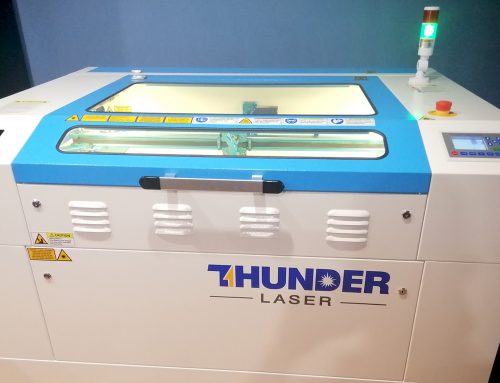
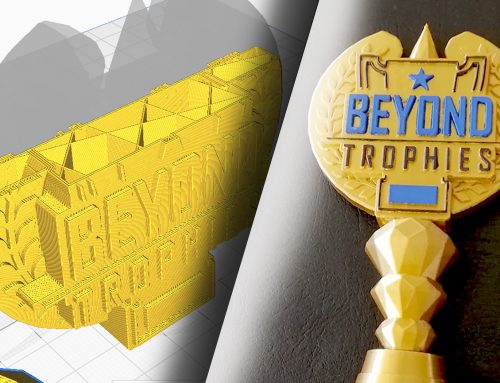
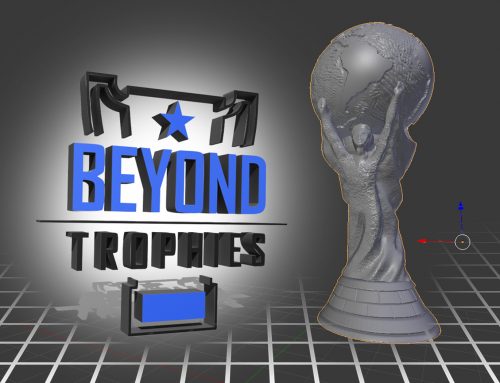


This is grand work, thanks ever so much for going to all the trouble to write this in such an engaging and eloquent way. I looked at fiber laser when I started my business and spoke to the usual suspect supplier you mention and on hearing the starting prices (compared to the lovely, relatively simple world of rotary engraving) my only response was: ‘ahem, right. okay, well I’ll start with a machine that’s about 10% of that price then and put up with all the variables you get with cutters, nose cones and the overall seemingly legacy world of rotary. however, seeing as how we’re working solely with brass, it makes a little more sense.
Your thoughts overall re: cheap v expensive make absolute sense. How to double productivity: have 2 x machines running at once! Easy when you say it that fast, but practical and possible courtesy of our Jinan-based friends.
I didn’t know anything about RDWorks either, it does indeed sound horrendous, but you make those swings / roundabouts super-clear. Additionally, I have a softspot for RDworks because RD are my initials. Maybe that’s a sign. Either way, we’re a way off moving from rotary to anything else here, but you never know and it’s great to read this sort of hardcore experience at the coal face to help inform us (well, me) on the way.
Thanks ever so much. Great writing. Please do more!
Hi Raymond, thank you for the kind words. It’s hard to find information and reviews regarding Chinese laser engravers and software these days, so I’m definitely happy to fill this need. The biggest problem with choosing a Chinese machine is that there’s just so many of them out there. Most of them are nearly identical, save for the workmanship of the guy who builds it. I’ll be purchasing other laser engravers soon, so I’ll review them as well 😉
Hello Great review! Thanks for the information I’m looking to buy a Laser and I Found the Derek company , Would you recommended? i had a bad experience before with INTECHCNC.
Hi Carlos, I would recommend them, though I’d still do your homework on the latest machines from other manufacturers. Companies change all the time, and the quality of your machine can sometimes boil down to the individual person who built it. A good starting point would be somewhere like alibaba.com as the makers sell from there. When looking through machines, note the ones that specify the use of better quality components compared to regular machines (like cables, rails, stepper motors, power supply, etc). Upgraded quality components do matter a lot.
The Jinan Derek company I brought mine from were very responsive and helpful when problems arose. They have good customer service, and their machine was decently built (though they used cheap flimsy cable in the X-axis rail, which is starting to show).
Fantastic article, however, I must add to it. An important yet commonly overlooked problem with thermal related cutting is thermal expansion. Water Jet has a small amount of thermal expansion which leaves most parts within tolerance. While Plasma, Burning and Laser cutting all apply heat which, if not planned for in setup, can put parts out of tolerance from a few mm to a few cm.. in some thicker materials even inches.
And maybe just a little thing to point out: Trotec lasers are made in Austria.
Hi, I’m about to buy a 1400x900mm, 150W laser from Jinan Derek as well, I’m glad to read this review and see that they provided a good service. After some years of use, would you still recommend them? Any issues I should be aware of? It’s kind of a big investment and I can’t find many reviews of their company.
Hi Matt, after 4 years of owning this machine, it is still going strong. After that time, it did develop a design flaw with the cabling in the X-Axis rail chain, as the wires have broken now and the auto level and red dot pointer no longer work. The machine still runs perfectly fine, and I manually level my jobs and align them without a pointer, so it’s no big deal.
Having said that, Jinan Derek have assured me that the flimsy wires in the X-Axis cable chain have been sorted out.
One really good thing I’ve found over the years about Jinan Derek is their customer service. They are very prompt and helpful at all times.
The catch with my recommendation is that I haven’t tried other companies, so I don’t know where Jinan Derek really stands in the grand scheme of things. I’ve tried to look up prominent laser engraver makers over there, and the information is not all that available.
I hope that helps 🙂
THank you very much for the reply! It does really help a lot and tilts my decision towards them. Their sales rep have been the most helpful of the ones I have contacted. Of course you never know as they’re all trying to sell anyway, but the others were just focused on the price and “buy now, buy buy now”. But Jinan Derek have been very patient in answering all my questions and I noticed they focus on quality, mentioning brands they use on their parts etc.
I think I’ll place my order today, fingers crossed.
Thanks again!